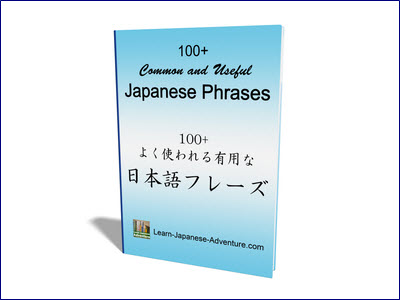- Home
- Basic Lessons
- Japanese Particles Change
Change of Japanese Particles
in Negative Answers -
Free Japanese Lessons: 14
One thing that most people get confused about Japanese particles is that you need to change them when giving negative answer to a Yes/No question.
Besides, it's also important on where to add the particle は (wa) because the the meaning of the answer changes depending on the position of where you placed は (wa).
Changing Japanese Verbs into Negative Forms
Before going into the change of Japanese particles, let's see how to change Japanese verbs into their negative forms.
To change Japanese verbs to their negative forms, you just need to change the ます (masu) to ません (masen), such as...
- たべます (tabemasu) becomes たべません (tabemasen) - don't eat
- のみます (nomimasu) becomes のみません (nomimasen) - don't drink
- よみます (yomimasu) becomes よみません (yomimasen) - don't read
To show how to use the above in a sentence, see the following examples...
- わたしはたまごをたべません。
watashi wa tamago wo tabemasen
Meaning: I don't eat egg.
- わたしはコーヒーをのみません。
watashi wa ko-hi- wo nomimasen
Meaning: I don't drink coffee.
- わたしはしんぶんをよみません。
watashi wa shinbun wo yomimasen
Meaning: I don't read newspaper.
Japanese Particles Change in Negative Answers
Let's see how to answer this Yes/No question as follow...
- Question: あなたはまいあさコーヒーをのみますか。
anata wa maiasa ko-hi- wo nomimasu ka
Meaning: Do you drink coffee every morning?
You can answer the above question in 2 ways...
- Answer 1: いいえ、わたしはまいあさ は コーヒーをのみません。ときどきのみます。
iie, watashi wa maiasa wa ko-hi- wo nomimasen. tokidoki nomimasu
Meaning: No, I don't drink coffee every morning. I drink sometimes.
- Answer 2: いいえ、わたしはまいあさコーヒー は のみません。こうちゃをのみます。
iie, watashi wa maiasa ko-hi- wa nomimasen. koucha wo nomimasu
Meaning: No, I don't drink coffee every morning. I drink tea every morning.
As you can see from answer 1, the particle は (wa) was added immediately after まいあさ (maiasa) to emphasize that it's NOT every morning that I drink coffee, but only sometimes.
Whereas for answer 2, を (wo) is changed to は(wa) after コーヒー (ko-hi) to emphasize that it's NOT coffee that I drink every morning, but tea.
Rules for Japanese Particles Change in Negative Answers
In general, the rules for the Japanese particles change in negative answers are as follow...
Rule 1: None/を/が/も → は
Meaning: When there is no particle or the particle is either を, が or も, change it to は.
Rule 2: Other Particles → Particle + は
Meaning: If the particle is neither を, が nor も, add は to the particle.
(に → には, と → とは, で → では, へ → へは, etc)
Let's use an example to show how to apply the above rules on Japanese particles...
- Question: あなたはまいにちかいしゃへいきますか。
anata wa mainichi kaisha e ikimasu ka
Meaning: Do you go to office every day?
- Answer 1: いいえ、わたしはまいにち は かいしゃへいきません。げつようびからすいようびまでいきます。
iie, watashi wa mainichi wa kaisha e ikimasen. getsuyoubi kara suiyoubi made ikimasu
Meaning: No, I don't go to office every day. I go to office from Monday to Wednesday.
- Answer 2: いいえ、わたしはまいにちかいしゃ へは いきません。がっこうへいきます。
iie, watashi wa mainichi kaisha ewa ikimasen. gakkou e ikimasu
Meaning: No, I don't go to office every day. I go to school every day.
Another example...
- Question: あなたはくじにひこうきにのりますか。
anata wa kuji ni hikouki ni norimasu ka
Meaning: Do you get on the air plane at 9 o'clock?
- Answer 1: いいえ、わたしはくじ には ひこうきにのりません。じゅうじにのります。
iie, watashi wa kuji niwa hikouki ni norimasen. juuji ni norimasu
Meaning: I don't get on the air plane at 9 o'clock. I get on at 10 o'clock.
- Answer 2: いいえ、わたしはくじにひこうき には のりません。でんしゃにのります。
iie, watashi wa kuji ni hikouki niwa norimasen. densha ni norimasu
Meaning: I don't get on the air plane at 9 o'clock. I get on the train at 9 o'clock.
Please take note that the above rules apply only if you are answering a Yes/No question in negative ways. Normal negative sentence would not need to change particle or add は (wa) to other Japanese particles.
However, sometimes even for normal negative sentence, people change the Japanese particle in order to emphasize something. For example...
- わたしはコーヒー を のみません。
watashi wa ko-hi- wo nomimasen
Meaning: I don't drink coffee.
was changed to...
- わたしはコーヒー は のみません。
watashi wa ko-hi- wa nomimasen
Meaning: I don't drink coffee.
...to emphasize that I don't drink coffee, but drink other beverage.
If you want to know more about particles, I recommend you get one of these books on particles.
Related Pages
Lesson 11: Particles.
Lesson 15: Particles ka and mo with Question Words.
Lesson 16: Particles to and de.
Lesson 24: Particles wa and ga.
Lesson 27: Particle to for Quotation.
Intermediate Lesson 14: Particle ga for Introduction.
Intermediate Lesson 18: Particle de with more Functions.
Best Deal of the Year! Get 68% OFF Lifetime Premium! Ends on 13 Dec 2025
Click Here to Get 68% OFF Lifetime Premium and be on the fast track to fluency in Japanese.
The link above is an affiliate link, which means that I would earn a commission (at no extra cost to you) if you do end up purchasing the related learning course.
Previous - Lesson 13: Japanese Nouns Part 3
Buy me a coffee









Facebook Comments
Don’t see the comments box? Log in to your Facebook account, give Facebook consent, then return to this page and refresh it.